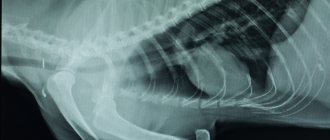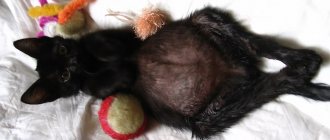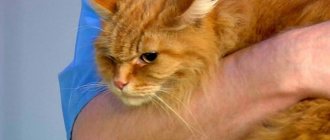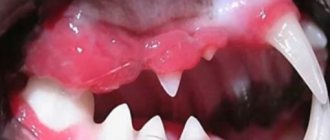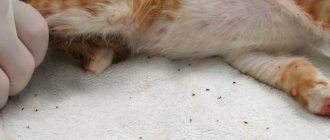Viral immunodeficiency in cats (infectious immunodeficiency virus, FIV, feline immunodeficiency virus, FIV) is a severe, predominantly latent (latent) deadly, incurable infection, which is characterized by serious damage to the entire immune system of animals.
The disease is also known as feline AIDS. It is essentially the feline equivalent of the human immunodeficiency virus (HIV), which causes the development of AIDS. The disease in cats progresses very slowly, but can complicate the course of other diseases and pathologies.
Symptoms and signs of infection increase gradually and may appear only after several years. In veterinary medicine, in most cases, the immunodeficiency virus is detected in middle-aged, older, and elderly cats that roam freely on the street.
The causative agent of the disease
Feline viral immunodeficiency is caused by a retrovirus belonging to the Retroviridae family, the Lentivirus group. The diameter of the pathogen does not exceed 100-116 nm.
Important! FIV was first isolated in 1987 from a cattery in North Carolina. In a large group of individuals the disease was chronic. Scientists gave the new, previously unknown virus the name T-lymphotropic lentivirus of cats (TLLV), but subsequently, according to the international classification, its name was changed to FIV - feline immunodeficiency virus.
The causative agent of this infection is not resistant to environmental conditions and, under unfavorable conditions, quickly loses its virulence.
- Temperatures of 55-60 degrees lead to its inactivation after 25-35 minutes.
- Higher temperatures and boiling destroy the virus almost instantly.
- At room temperature, FIV remains virulent for three to four days.
- The feline immunodeficiency virus is relatively resistant to ultraviolet radiation.
- Lentiviruses quickly lose their activity when exposed to various disinfectant solutions.
- Esters, alcohol, and aggressive chemical compounds kill dangerous pathogens almost instantly, within three to six minutes.
Antibodies to this virus have been detected in many representatives of the cat family living in zoos and in the natural environment around the world. At the same time, several strains of lentivirus have been isolated from wild cats. Antibody titers vary depending on age, conditions, and environment.
Recent data suggests that the prevalence of FIV in the UK is 13-15% among infected cats, with only 1-3% being latent carriers who do not show major signs of the disease. In America, lentivirus affects approximately 3-6% of animals. It has also been noted that males are more susceptible to feline AIDS.
When conducting diagnostic studies, FIV is detected in the saliva, bloodstream, and other physiological fluids of sick cats. After infection, the lentivirus remains in the body of infected animals for life, since immune antibodies cannot destroy it.
What is feline immunodeficiency virus?
Feline immunodeficiency is a viral disease. And this virus, according to medical classification, belongs to the family Retroviridae, genus Lentivirus. Interestingly, it was first identified in 1987, in the decade when such a terrible phenomenon as HIV was first discussed.
Then in Northern California, in one of the nurseries, a previously healthy population of cats became ill with an unknown virus. Studies have shown that it is a lentivirus, and just like HIV, it causes extremely dangerous consequences - AIDS in cats. Moreover, approximately 50% of infected animals have an increased risk of secondary infections.
FIV in cats Since then, this phenomenon has been well researched, and today veterinarians know much more about it. For example, the fact that it is no less common than viral leukemia, and that the average age of pets diagnosed with this disease is 5 years.
Interesting! Studies have shown that this dangerous disease develops more often in cats than in cats, but why this happens is not yet clear.
Another interesting point is that FIV in cats is most often recorded in those animals that are kept in outdoor conditions, as well as in large nurseries, where changes in livestock occur quite often. According to various estimates, approximately 8-12% of all cats on the planet have this virus.
[custom_ads_shortcode1]
How cats become infected with FIV
Considering that FIV is not resistant to external factors, cats are infected through bites and scratches, since the maximum concentration of lethivirus is contained in the saliva of infected individuals. When bitten, the skin and mucous membranes are damaged, the virus, penetrating the body of healthy cats, begins to multiply quickly.
The infection is transmitted through contact and sexual contact. Infection occurs through direct close contact or mating of healthy and infected animals.
The transplacental (intrauterine) method of infecting cats with the immunodeficiency virus was experimentally confirmed. The infection is also transmitted to newborn kittens through the milk, colostrum, and saliva of an infected mother cat . Congenital feline AIDS appears a few days after the babies are born.
FIV can be transmitted by blood-sucking insects and parasites . Ticks, fleas, and lice eaters can cause lentiviruses to enter the body of domestic cats, which leads to the development of a dangerous infection. Cases of animal infection following blood transfusion have been reported.
Causes of the disease
Feline AIDS is not dangerous for people; the virus develops exclusively in the body of mustaches. Veterinarians say that cats that carry the virus are more likely to suffer from toxoplasmosis and leukemia.
A common route of transmission of the virus is contact, when it enters the body through skin injuries received during a fight. Saliva contains a huge number of virions. Penetrating into the blood, they begin to multiply rapidly.
The risk group includes uncastrated and unsterilized animals, for which fighting is a way of defending their territory. In cats, immunodeficiency is diagnosed more often than in cats.
Other methods of retrovirus transmission include:
- sexual;
- insect bites (fleas, ticks);
- blood transfusion;
- intrauterine (from mother to offspring);
- breastfeeding (through contaminated milk).
Virions are not stable in the environment, are sensitive to ultraviolet rays and die at high temperatures.
In shelters and nurseries, the risk of infection of healthy animals from virus carriers is very high. This is due to the high density of the cat population. In addition, diagnostic studies among breeding and breeding specimens are carried out only by bona fide breeders. Negligence in maintenance often becomes one of the common reasons for the spread of the virus.
Who is susceptible to infection?
The feline immunodeficiency virus is widespread. Veterinary services register outbreaks of a deadly infection in all countries of the world. Both wild cats living in cities and rural areas, as well as pets that go outside for walks, can become infected.
According to statistics, stray cats and free-ranging animals are at greatest risk of contracting FIV. Considering that males more often get into fights with their relatives, protecting their territory, cats, unlike cats, are more susceptible to infection. It is also worth noting that animals of older age groups have more aggressive and antisocial behavior, so their risk of infection is higher than that of small kittens or young animals.
Important! A high percentage of cats being infected with feline immunodeficiency is noted in places where these animals gather in large numbers. That is, where cats, living in groups, are in close contact with each other.
If animals, for example, purebred domestic cats, have little contact with their relatives and go for walks under the supervision of their owners, the likelihood of horizontal infection is extremely low.
Severely weakened, emaciated individuals, cats suffering from various chronic, systemic pathologies, uncastrated males, females, pets with a weak immune system are susceptible to infection with the feline immunodeficiency virus.
The risk of contracting this infection increases in nurseries, shelters, and in places where cats are kept in groups with a dense population. If diagnostic measures are neglected and there is no control over the health of animals involved in breeding, the feline AIDS virus is quickly transmitted to other cats from latent carriers.
Disease prognosis
The prognosis is determined by the strain of the pathogen, the state of the cat's immune system, and whether it receives treatment and proper care. The life expectancy of infected cats is lower than that of uninfected cats; the average difference is 1–2 years. At the same time, the life expectancy of a pet with advanced clinical immunodeficiency rarely exceeds 1–2 years, so the prognosis for life in each specific case can be difficult to determine. In some cats, the virus remains in a latent state throughout its life and has no clinical manifestations.
How dangerous is FIV for cats?
The main danger of this infection is that several months or years pass from the moment of infection to the appearance of clinical symptoms. The viral infection has a hidden, latent course, which makes its early diagnosis difficult.
After penetration into the animal’s body, the lentivirus begins active reproduction in the body. The pathogen affects the cells of the immune system, leading to the death of lymphocytes, which negatively affects the general condition of our little brothers.
FIV is a deadly viral infection that will invariably lead to the death of the infected individual.
Therapeutic measures are symptomatic in nature and are aimed at relieving the symptoms of the underlying disease and increasing the immune potential of the infected animal.
Note that due to the polymorphism of clinical manifestations, diagnosis is difficult. Symptoms in FIV-infected animals are similar to those of other infections and diseases. To accurately confirm that a cat is infected with the immunodeficiency virus, a number of complex diagnostic measures and studies are carried out. The tests are expensive and not available in all veterinary clinics and laboratories.
I have FIV, pet me
On December 22, there are so many people greeting you at Domodedovo that you can barely push your way closer to the fence where people have gathered to quickly hug their arriving loved ones. Ksenia doesn’t know who she’s waiting for. She simply looks at the bags of passengers leaving the baggage claim area. Maybe they will carry it in their hands? Will they put it on top of the suitcase? What if the control didn’t pass? The worst thing is: what if he couldn’t survive the flight?
It turned out that the cat survived everything, says Ksenia Vasilchenko, a volunteer at the Kozhukhovsky animal shelter: “The woman who brought him to me from Montenegro said that my new charge has a 'Nordic character'.”
On the Aeroexpress, the ginger cat falls asleep, and Ksenia examines him: three and a half paws, missing teeth. How can we know what he was doing on the streets of Budva until volunteers picked him up? The cat doesn't tell.
“In fact, this is an unusual situation. Usually we take stray animals from Russia to new owners in Europe, and not vice versa. – says Ksenia. “Montenegro, Serbia, Romania, unfortunately, became famous for their cruel approach to regulating the number of dogs and cats on the street, so the three-legged cat had to be taken away from the sea and the sun.”
The next day, Red goes to the vet. The doctor finds ticks in the ears, flea remains on the fur, and inflamed gums. He had already been to veterinary clinics in Montenegro, but, as Ksenia’s colleague from Budva said, “they don’t know how to treat people here.” This is not what they saw and treated in Moscow. Animals that come to the shelter have tumors, severe infections, and skin diseases. The main thing is that everything is in order with the internal organs, then the cat can be adopted. All that remains is to take blood from a vein for biochemistry.
“Look, a drop of his blood on my hand coagulated in a couple of seconds,” says the doctor after drawing blood. “Maybe we can test for leukemia and immunodeficiency?”
First came the general blood biochemistry. Everything is normal, we can operate on his teeth. Ksenia can already imagine how the cat is lying on the pillows in the house of her new family. The second results came from tests for viruses. Red was diagnosed with FIV - feline immunodeficiency virus. All dreams are crushed. For a cat in our country, this is a sentence to complete isolation. People like him are put to sleep out of ignorance and fear.
Ksenia has been working with animals for a long time. She knows that FIV is not transmitted to people: neither adults nor children. Despite all the efforts of volunteers, when people hear the phrase “cat HIV”, they are afraid to even pet the animal. Cats suffer just as much stigma as humans.
Red and Ksenia
There is no cure for FIV as such. Some veterinarians believe that human ARV therapy is suitable for cats. In practice, symptomatic treatment is necessary: good food, absence of stress and infections, regular testing for antibodies and monitoring the dynamics. With good care, cats with FIV can live long and happy lives.
“Instead of treatment, animals with this diagnosis are sometimes simply thrown out into the street, because the owners read somewhere on the forum that FIV is dangerous for small children. According to veterinarians, people are ashamed to admit that their cat has an immunodeficiency. It’s easier to be scared and not want to understand the issue. Some veterinarians also know little about the virus and offer euthanasia,” Ksenia complains.
FIV is not harmful to other animal species. The only restriction: a cat with this disease must be the only one in the house. You can get FIV from a mother cat, but most often animals become infected after a street fight with already sick cats or during mating.
The disease has an incubation period, an acute disease, a latent period and a terminal state. “Our Redhead has a latent period. The only visible signs are terrible teeth and inflamed gums. We can't let him go outside, let him lie in a draft and get sick. We need to feed him good food, donate blood regularly and love him.”
A person must understand that at some point the cat will begin to fade away. On the other hand, even completely healthy cats have short lives. People usually know that they will outlive their pet. Cats with FIV can live for five or ten years.
It is almost impossible to believe that someone would want to adopt a three-legged, toothless ginger cat with FIV. But Red now has a home - it’s almost a New Year’s miracle. Friends responded and a wonderful family takes him in as their only cat. Now he will have his own bowl, favorite chair and loving “parents” - everything like normal cats. Because there is no reason why such wonderful creatures do not deserve care and love. Charismatic Red is no worse than other, “normal” cats. Maybe even a little better. Previously, AIDS.CENTER talked about cats living with FIV in Australia.
Is FIV transmitted to humans and other animals?
Considering the similarity between FIV and the HIV virus, owners of furry purrs are interested in the following questions: “Is feline AIDS transmitted to humans?”, “Can you get infected from an infected cat?”, “Is FIV transmitted to dogs and other pets?”
Even if it so happens that your pet is diagnosed with a terrible illness, it has been scientifically proven that the feline AIDS virus is not dangerous to humans and is not transmitted to dogs or other pets.
The causative agent of this infection multiplies and is active only in the body of representatives of the cat family. Therefore, if it happens that your furry pet is diagnosed with a dangerous infection, it is impossible to infect humans or other pets with this disease.
But if there are several cats in the house and one of them is infected with lentivirus, it is possible that all of them will be latent virus carriers, since the animals are in close contact with each other.
Considering that kittens are adopted at two to three months of age, there is a slight risk. However, if cats do not walk on the street, you pay attention to your pets, promptly take the cat to the clinic for preventive diagnostics and tests, and you are confident that other animals are not carriers of FIV, the risk of spreading this disease is not so great.
Vaccine
As with HIV, the development of an effective vaccine against acquired immunodeficiency syndrome in cats is difficult due to the large number and variations of viral strains.
“Single-strain” vaccines, that is, vaccines that protect against only one variant of the virus, have already demonstrated good effectiveness against homologous strains of the feline AIDS virus. A dual-subtype vaccine for FIV, released in 2002 under the name Fel-O-Vax, immunized cats against more strains of the feline AIDS virus. It was developed using inactivated isolates of two of the five FIV subtypes (or clades): A Petaluma and D Shizuoka.
The vaccine was shown to have moderate protection (82% of cats were protected) against FIV subtype A, but a later study found that it did not provide protection against subtype A. It was 100% effective against two different strains of FIV subtype B. Vaccination will to cats testing positive for FIV, making diagnosis difficult. For these reasons, the vaccine is considered "non-essential" and the decision to vaccinate should be made after discussion with your veterinarian and consideration of risks versus effectiveness.
Symptoms and manifestations of immunodeficiency
The effects of the feline immunodeficiency virus on the cat's body are similar to those of the human immunodeficiency virus (HIV). Initially, after the penetration of a retrovirus, it primarily replicates in the cells of the lymphatic system, disrupting its functioning. The virus multiplies in the lymph nodes.
The action of the retrovirus is aimed at the cellular structures of the immune system. If an infection occurs, the immune system becomes vulnerable to viruses, bacteria, and protozoan parasites.
Against the background of FIV, sick animals often develop secondary infections and systemic diseases. If a cat is infected with FIV and a secondary viral or bacterial disease develops, the effectiveness of antibiotic therapy decreases and the treatment period increases.
Important! The immunodeficiency virus leads to a change in the percentage of CD4 and CD8 lymphocytes in the bloodstream compared to the physiological norm.
Signs of a viral infection are nonspecific. The intensity of their manifestation, the duration of the incubation period, which can last from three to four weeks to one and a half months, depends on the individual, physiological characteristics, age, conditions of the animal, activity and state of the immune system.
The acute stage of the disease gradually turns into a chronic form of the disease, which can last several months or years.
Symptoms and signs of the acute stage of FIV:
- unstable body temperature, hyperthermia;
- anemic mucous membranes;
- depressed state, decreased response to stimuli;
- weakness, drowsiness, apathy;
- loss of appetite, sudden weight loss, exhaustion;
- lymphadenopathy, enlargement, pain of lymph nodes;
- digestive disorders, prolonged diarrhea;
- deterioration of wool;
- lacrimation;
- inflammation of the ear canal;
- disruptions in the functioning of the genitourinary tract;
- difficulty breathing, irregular heartbeat;
- discharge from the nasal passages, eyes;
- allergic rashes, chronic dermatosis.
Important! In cats with immunological problems, autoimmune diseases, as well as in animals suffering from leukemia and other diseases, the symptoms of FIV are more pronounced and intense.
The first signs appear, as a rule, two to four weeks after the pathogen enters the body. Often the symptoms of FIV are similar to those of viral leukemia.
In the acute form of FIV in cats, the temperature rises sharply to 40-41 degrees, after which after a few days it returns to normal limits. Animals quickly get tired and become inactive. Very often, signs of infection are purulent, ulcerative gingivitis, stomatitis, periodontitis of varying degrees of complexity, conjunctivitis, uveitis, keratitis, and other systemic pathologies.
The most common signs of the initial form of FIV are diseases of the oral cavity, respiratory, and gastrointestinal tracts. There are obvious signs of fever and malaise on the face. Animals become apathetic and cease to be actively interested in the world around them. Cats seclude themselves in dark places, are reluctant to make contact with their owners, and refuse active games and favorite treats.
Good to know
- Plague in cats. How to avoid infecting your pet?
- Feline panleukopenia. What to do after getting sick?
- Viral Leukosis in Felines (Diagnostics, Tests)
- Leptospirosis in cats. Vaccination
- Viral leukemia in cats (symptoms and treatment)
- Hemobartonellosis in cats and dogs (pathogenesis, diagnosis). Control and prevention measures for hemobartonellosis in cats
- Borreliosis in animals and humans
- FLV in cats (epizootology, diagnosis and treatment) FeLV for cats
- Feline viral leukemia
Other manifestations of FIV in cats
In infected pets, in addition to a decrease in immune potential, symptoms of secondary, opportunistic infections (demodex, notoedrosis, chlamydia, calcivirus, pneumonia, bronchitis, candidiasis, cystitis, colds) are often noted.
Important! FIV carriers develop monocytosis, thrombocytopenia, acidosis, monocytosis, and acute anemia, which is confirmed by serological studies.
Very often, infected cats show signs of fungal infections and infectious dermatitis. The pet's code is affected by pathogenic fungi.
With this infection, the risk of developing squamous cell carcinoma, lymphosarcoma, and other oncological pathologies increases. It has been established that the feline immunodeficiency virus can provoke neuropathies, but this is not one of the main signs of this disease. In infected cats, the central nervous system is affected and encephalopathy is noted.
Diagnostics
To accurately diagnose VIC, a comprehensive diagnosis is performed. In addition to a general examination, clinical manifestations, and anamnesis data, the epizootological situation in the region regarding this infection is taken into account.
The diagnosis is made based on the results:
- ELISA (enzyme-linked immunosorbent assay). The method is based on thin layer chromatography. Shows the reaction of antigen and antibodies in biomaterials. Conducted using special test systems. The antigen is detected in the bloodstream of infected cats three to four to six weeks after infection.
- Serological studies (general, biochemical blood test). Signs of anemia, a decrease in lymphocytes, changes in the leukocyte formula, and hyperglobulinemia are noted.
- Differential diagnostics, CPR.
If necessary, other physiological fluids (urine, tear secretion, saliva, lymph) are subject to examination. Kittens that were born from an FIV-infected cat should be taken to the veterinary clinic for examination. Babies are tested up to three to five months and then regularly once a year.
Important! If there is a suspicion of FIV infection, in order to get the most detailed picture and not make a mistake in making a diagnosis, studies are carried out no earlier than two to three months from the moment of the suspected infection. Early diagnosis may show an inaccurate, false result due to the lack of production of antibodies to virions that have entered the body.
During postmortem examinations, muscle dystrophy, exhaustion, edema of the lungs and bronchi, and atrophy of some lymph nodes are noted.
Symptoms and signs of infection in a cat
Cat at the veterinarian's appointment
Now we need to understand how HIV progresses in cats; its symptoms will differ depending on the stage of the disease. So, after infection, not only an increase in temperature can be observed, but also a decrease in appetite and exhaustion, while a blood test will show leukopenia, that is, a decrease in the level of leukocytes in the blood.
In the second stage of the disease, fever is rare. The main symptoms are associated with secondary infections; for example, most animals suffering from this disease have chronic stomatitis and some pathologies of the nasopharynx. Females are often diagnosed with toxoplasmosis. Skin diseases develop that are associated with bacterial or fungal infections, and sometimes with parasitic infections.
Chronic rhinitis with constant nasal discharge, regular diarrhea - all this can also be symptoms of FIV infection.
Interesting! Clinical practice shows that in approximately 18% of cases, the HIV analogue in cats is asymptomatic, and then begins to progress, but slowly. And in approximately the same number of cases, an intensive course of the disease is recorded.
Direct FIV infection can cause neurological diseases, including behavioral disturbances and poor motor coordination.
Treatment
Unfortunately, at the moment there is practically no treatment for FIV, and this infection is incurable. Therapy and therapeutic measures are primarily aimed at eliminating the main symptoms of secondary diseases and infections, strengthening the immune potential.
In the treatment of FIV-infected cats, specific immunoglobulins, anti-influenza, anti-measles serums, and antiviral drugs (zidovudine) are used. To normalize the animal’s condition, 0.5-1 ml of immunoglobulin is administered intramuscularly or subcutaneously every two to three days. Immunomodulators (interferon, acemannan) have a positive effect, but can cause side effects.
To suppress the activity of pathogenic flora, a course of antibiotic therapy and sulfonamides is prescribed. Broad-spectrum antibiotics or certain drugs that act on specific pathogens are used. The course of treatment is five to seven days. The medications, dosage, and frequency of administration are prescribed by the attending veterinarian.
In some cases, good results are observed after short-term use of corticosteroids, which relieve inflammation, but non-steroidal anti-inflammatory drugs are used extremely carefully when treating FIV-infected cats.
To strengthen the immune system, animals are required to be prescribed multivitamin, vitamin-mineral complexes, and homeopathic preparations. Antihistamines (tavegil, suprastin) are prescribed.
Treatment of immunodeficiency virus in cats
Because FIV-infected cats can live for years without any symptoms, treatment may not be necessary until symptoms indicate disease progression.
Secondary infections are common in the later stages of FIV infection due to the progressive weakening of the immune system. Problems can range from mild to severe and will be considered on a case-by-case basis.
Certain problems that can arise with advanced FIV, such as dental infections and tumor development, may need to be addressed with surgery. Cats with severe dental disease may need all their teeth removed to relieve pain caused by gingivitis and other oral problems.
Your veterinarian may also recommend a special dietary plan to address your cat's specific health concerns.
Cats with FIV infection should be monitored by you at home and seen regularly by a veterinarian. This will help detect the development of secondary infections and other manifestations of the disease.
Progressive health problems, such as gradual weight loss and increasingly frequent secondary infections, may be signs that FIV is beginning to affect your pet's quality of life.
But in general, the earlier FIV is detected, the better your cat's chances of living a long and relatively healthy life.
Caring for FIV animals
The prognosis for diagnosing FIV is disappointing and cautious. The infection is incurable, but even if the diagnosis is positive, this is not a reason for euthanasia. Some FIV cats live quite a long time and die of old age. Viral immunodeficiency is not always the main cause of death. Infection only aggravates associated secondary diseases. The life expectancy of cats with FIV depends on age, physiological, individual indicators, conditions of detention and care.
Owners of infected animals should understand that their furry pet needs increased attention and care. Do not forget that a cat is a lifelong carrier of the virus, so it is worth protecting your pet’s communication not only with stray animals, but also with other cats.
At home, it is very important to create optimal living conditions for your cat. Protect your cat from stress, potential carriers of infection. Avoid hypothermia or overheating of your pet. Regulate your level of physical activity.
Strengthen your cat's immunity with special complex supplements and vitamin preparations. Carry out deworming and treatment of the coat against ectoparasites in a timely manner. As for vaccination, infected cats need to be vaccinated extremely rarely and only as indicated by a veterinarian. Inactivated sera and killed vaccines are used. Clinically sick animals are not vaccinated!
If you follow the doctor's recommendations, a pet infected with the immunodeficiency virus can live a happy life for several more years.
Preventive measures against immunodeficiency
There is a vaccine against FIV, but it is used extremely rarely due to the lack of evidence of its effectiveness against all types of the virus.
The main preventive measure to prevent the spread of the immunodeficiency virus in cats continues to be control over their population and maintenance in nurseries, improving the quality of care, and reducing the number of homeless individuals.
Animals, especially kittens, living in a cattery must be kept in proper conditions. Particular attention is paid to cleanliness and disinfection. Overcrowding in closed spaces can lead to an outbreak. If at least one cat is infected, then the probability of infection of other individuals who are in constant contact with the sick animal is very high.
Cats kept in poor conditions, in crowded conditions, are more likely to show aggression, sort things out, and bite. Wounds and saliva that gets into them are a direct source of FIV infection.
Many owners of sick animals, not knowing what to do or how to treat a dangerous disease, decide to have their pet euthanized. Veterinarians assure that there is no need to euthanize a cat, but owners must understand the danger an infected individual poses to other pets living in the house.
For this reason, an infected cat should be isolated, excluded from breeding and sterilized (it should not reproduce). Such measures will prevent the spread of infection.
New cats arriving at the shelter must quarantine for at least 14 days. Isolation will reduce their anger and aggressiveness, and therefore the likelihood of infection. If a cat is diagnosed with FIV after testing, it should also be kept in isolation and tested regularly.
The infection cannot be transmitted through dishes and other hygiene items. Ventilation and treatment of premises, strengthening the immune system of cats by fortifying the body, isolating sick individuals are the main preventive measures.
Video
Prevention
At the moment, FIV is a poorly studied infection, so a preventive vaccine against this infection has not been developed in our country or abroad. It is very important to prevent your pet from contracting a dangerous infection. Monitor the cat’s condition and behavior, strengthen the immune system, and consider the correct diet. If the cat is kept on a natural diet, give fortified food supplements and complex vitamins to strengthen the immune system.
If a cat is walking on the street, we recommend spaying or sterilizing the animal. This will avoid uncontrolled mating and fights between individuals of the same sex. Uncoated males behave more aggressively and are intolerant of their relatives.
Do not neglect vaccinations and deworming. Systematically treat your pet with products against external parasites, regardless of whether the cat walks outside or does not leave the house. If you notice signs of illness, do not delay your visit to the veterinary clinic. Many diseases can be cured only in the early stages of development.


